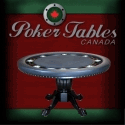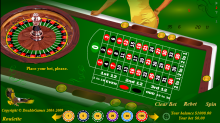Called (or call) bets or Announced Bets
 Although most often named “Call Bets” technically these bets are more accurately referred to as “announced bets“. The legal distinction between a “Call Bet” and an “Announced Bet” is that a “Call Bet” is a bet called by the player without him placing any money on the table to cover the cost of the bet. In many jurisdictions (most notably the United Kingdom) this is considered gambling on credit and is illegal. An “Announced Bet” is a bet called by the player for which he immediately places enough money to cover the amount of the bet on the table, prior to the outcome of the spin / hand in progress being known.
Although most often named “Call Bets” technically these bets are more accurately referred to as “announced bets“. The legal distinction between a “Call Bet” and an “Announced Bet” is that a “Call Bet” is a bet called by the player without him placing any money on the table to cover the cost of the bet. In many jurisdictions (most notably the United Kingdom) this is considered gambling on credit and is illegal. An “Announced Bet” is a bet called by the player for which he immediately places enough money to cover the amount of the bet on the table, prior to the outcome of the spin / hand in progress being known.
There are different number series in roulette that have special names attached to them. Most commonly these bets are known as “the French bets” and each covers a section of the wheel. For the sake of accuracy, Zero spiel although explained below is not a French bet, it is more accurately “the German bet”. Players at a table may bet a set amount per series (or multiples of that amount). The series are based on the way certain numbers lie next to each other on the roulette wheel. Not all casinos offer these bets, and some may offer additional bets or variations on these.
Voisins du zero (“neighbors of zero”)
This is a name, more accurately Grand Voisins du Zero, for the seventeen numbers which lie between 22 and 25 on the wheel including 22 and 25 themselves. The series is 22,18,29,7,28,12,35,3,26,0,32,15,19,4,21,2,25 (on a single zero wheel).
9 chips or multiples thereof are bet. 2 chips are placed on the 0,2,3 trio; 1 on the 4/7 split; 1 on 12/15; 1 on 18/21; 1 on 19/22; 2 on 25/26/28/29 corner; and 1 on 32/35.
The bet on this section is very popular in Eastern Europe, most notably in the Czech Republic.
Jeu zero (“zero game”)
Zero game, also known as zero spiel (spiel is German for game or play), is the name for the numbers closest to zero. All numbers in the zero game are included in the big series, but are placed differently. The numbers are as follows: 12, 35, 3, 26, 0, 32, 15.
The bet consists of 4 chips or multiples thereof. 1 chip on 0/3 split, 1 on 12-15 split, 1 on 26 straight up and 1 on 32-35 split. Popular bet in Germany and many European casinos. This bet is also offered as a 5 piece bet in many Eastern European casinos. As a 5 piece bet it is known as zero spiel naca and includes, in addition to the chips placed as noted above, a straight-up on number 19.
Tier (“the third”)
This is the name for the twelve numbers which lie on the opposite side of the wheel between 27 and 33 including 27 and 33 themselves. The series is 27,13,36,11,30,8,23,10,5,24,16,33 (on a single zero wheel). The full name (although very rarely used – most players just call it as “tier”) for this bet is “le tiers du cylindre” (translated from French into English means one third of the wheel) because it covers twelve numbers (placed as 6 splits), which is as close to 1/3rd of the wheel as one can get. Very popular bet in British casinos. Tier bets out number Voisin and Orphans bets by a massive margin.
6 chips or multiples thereof are bet. 1 chip is placed on each of the following splits: 5/8; 10/11; 13/16; 23/24; 27/30; 33/36.
The Tier bet is also called the “Small Series” and in some casinos (most notably in South Africa) “Series 5/8” It includes the following wagers which are all splits
5/8, 10/11, 13/16, 23/24, 27/30, 33/36
A variant known as “Tier 5,8,10,11” has an additional chip placed straight up on 5, 8, 10 and 11; and so is a 10-piece bet.
Orphelins (“orphans”)
These numbers make up the two slices of the wheel outside the Tiers and Voisins. They contain a total of eight numbers, comprising 17,34,6 and 1,20,14,31,9.
5 chips or multiples thereof are bet. 1 chip is placed straight-up on 1 and 1 chip on each of the splits: 6/9; 14/17; 17/20 and 31/34.
“xx and the neighbors”
A number may be backed along with the 2 numbers on either side of it in a 5 piece bet. For example, “0 and the Neighbors” is a 5 piece bet with 1 piece straight-up on 3, 26, 0, 32 and 15. Neighbors bets are often put on in combinations, for example “1, 9, 14 and the neighbors” is a 15 piece bet covering 18, 22, 33, 16 with 1 piece; 9, 31, 20, 1 with 2 pieces and 14 with 3 pieces.
Any of the above bets may be combined, e.g. “Orphelins by 1 and Zero and the Neighbors by 1.” The “…and the Neighbors.” is often assumed by the croupier.
Final Bets
Another bet offered on the single zero game is “finals”. Most often pronounced finaal, but also finale (common with Italian speakers), and finals.
Finaal 4, for example, is a 4 piece bet and consists of 1 piece placed on each of the numbers ending in 4, that is 4, 14, 24 and 34. Finaal 7 is a 3 piece bet, 1 piece each on 7, 17 and 27.
Finaal bets from finaal 0 (zero) to finaal 6 cost 4 pieces. Finaal bets 7, 8 and 9 cost 3 pieces.
Some casinos also offer split-finaal bets, for example finaal 5/8 would be a 4 piece bet, 1 piece each on the splits 5/8, 15/18, 25/28 and 35.
Full Completes/Maximums
A complete bet places all of the inside bets on a certain number. Full complete bets are most often bet by high rollers as “Maximum Bets”.
The maximum amount allowed to be wagered on a single bet in European Roulette is based on a progressive betting model. If the casino allows a maximum bet of $1000 on a 35-1 straight-up, then on each 17-1 split connected to that straight-up $2000 may be wagered. Each 8-1 corner (covers four numbers) may have $4000 wagered on it. Each 11-1 street (covers three numbers) may have $3000 wagered on it. Each 5-1 sixline may have $6000 wagered on it. Each $1000 incremental bet would be represented by a token or “piece” that is used to specifically identify the player and the amount bet.
For instance, if a patron wished to place a full complete bet on 17, the player would call “17 to the maximum.” This bet would require a total of 40 pieces or $40,000 dollars. To manually place the same wager, the player would need to bet:
| Bet Type | Number(s) bet On | Pieces | Amount Waged |
|---|---|---|---|
| Straight-Up | 17 | 1 | $1,000 |
| Split | 17, 14 | 2 | $2,000 |
| Split | 17, 16 | 2 | $2,000 |
| Split | 17, 18 | 2 | $2,000 |
| Split | 17, 20 | 2 | $2,000 |
| Street | 17, 16, 18 | 3 | $3,000 |
| Corner | 17, 16, 13, 14 | 4 | $4,000 |
| Corner | 17, 18, 14, 15 | 4 | $4,000 |
| Corner | 17, 16, 19, 20 | 4 | $4,000 |
| Corner | 17, 18, 20, 21 | 4 | $4,000 |
| Six Line | 17, 16, 18, 13, 14, 15 | 6 | $6,000 |
| Six Line | 17, 16, 18, 19, 20, 21 | 6 | $6,000 |
| Total Bets Placed | 40 | $40,000 |
The player calls his bet to the croupier (most often after the ball has been spun) and places enough chips to cover the bet on the table within reach of the croupier. The croupier will immediately announce the bet (repeat what the player has just said), ensure that the correct monetary amount has been given while simultaneously placing a matching markers on the number on the table and the amount wagered.
The payout for this bet if the chosen number wins is 392 pieces, in the case of a $1000 straight-up maximum, $40,000 bet, a payout of $392,000. The player’s wagered 40 pieces, as with all winning bets in roulette, are still his property and in the absence of a request to the contrary are left up to possibly win again on the next spin.
Based on the location of the numbers on the layout, the number of chips required to “complete” a number can be determined.
- Zero costs 17 pieces to complete and pays 235 pieces.
- Number 1 and number 3 each cost 27 pieces and pay 297 pieces.
- Number 2 is a 36 piece bet and pays 396 pieces.
- 1st column numbers 4 to 31 and 3rd column numbers 6 to 33, cost 30 pieces each to complete. The payout for a win on these 30 piece bets is 294 pieces.
- 2nd column numbers 5 to 32 cost 40 pieces each to complete. The payout for a win on these numbers is 392 pieces.
- Numbers 34 and 36 each cost 18 pieces and pay 198 pieces.
- Number 35 is a 24 piece bet which pays 264 pieces.
Most typically (Mayfair casinos in London and other top class European casinos) with these “maximum” or “full complete” bets nothing (except the aforementioned maximum button) are ever placed on the layout even in the case of a win. Experienced gaming staff, and the type of customers playing such bets, are fully aware of the payouts and so the croupier simply makes up the correct payout, announces its value to the table inspector (floor person in the USA) and the customer, and then passes it to the customer, but only after a verbal authorization from the inspector has been received.
Also typically at this level of play (house rules allowing) the experienced croupier caters to the needs of the customer and will most often add the customer’s winning bet to the payout, as the type of player playing these bets very rarely bets the same number two spins in succession.
For example, the winning 40 piece / $40,000 bet on “17 to the maximum” pays 392 pieces / $392,000.
The experienced croupier would pay the player 432 pieces / $432,000, that is 392 + 40, with the announcement that the payout “is with your bet down Sir”.
There are also several methods to determine the payout should a number adjacent to a chosen number be the winner; for example, player bets 40 pieces on “23 to the maximum” and number 26 is the winning number. The most notable method is known as the “station” system or method; roulette dealing at this level is very complex and the exact methods are beyond the scope of this article – suffice it to say that a “good experienced croupier” would have no problem working with “stations”.
In some casinos, a player may bet full complete for less than the table straight-up maximum; for example, “number 17 full complete by $25” would cost $1000, that is 40 pieces each at $25 value.



